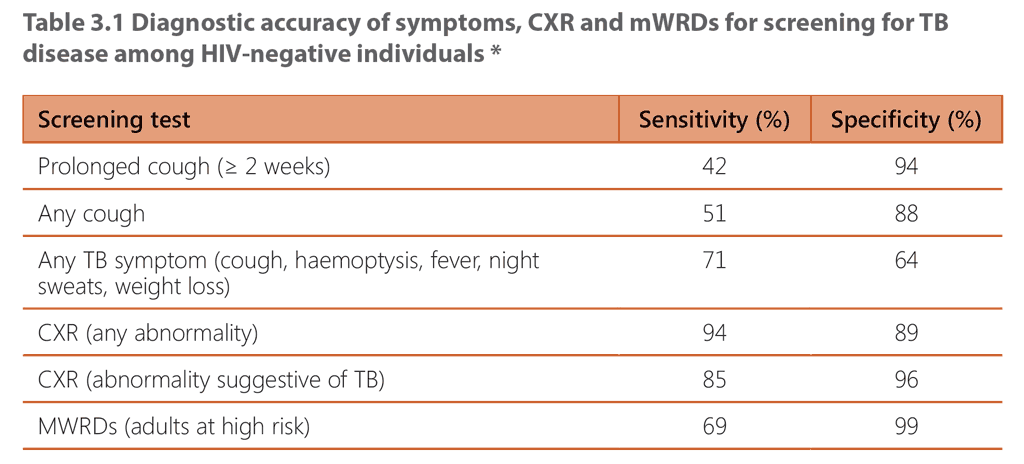Book traversal links for 3.1 Screening tools
Screening tests should distinguish between people with a high likelihood of having TB disease from those who are unlikely to have TB. A screening test is not intended to be diagnostic but rather to identify the subgroup of people with the highest likelihood of disease. Screening must always be conducted with a screening and diagnostic algorithm; thus, if people screen positive, they are referred to the next step in the algorithm, which could be a subsequent screening tool or diagnostic evaluation with bacteriological testing to confirm or rule out TB disease.
In general, high sensitivity is important for screening tests, as the goal is to detect TB disease early, although, if specificity is low at the screening stage, a significant proportion of people being screened who do not have TB disease will be referred for additional screening or diagnostic evaluation, with additional costs. Thus, the objectives of the screening programme must be considered when selecting a screening and diagnostic algorithm, including maximizing case detection (and thus prioritizing sensitivity) or maximizing efficiency (and thus prioritizing specificity). See 3.2 for further discussion of screening and diagnostic algorithms.
The tools for initial screening of the general population and high-risk groups (not including people living with HIV) include symptom screening for clinical features associated with pulmonary TB (including cough, haemoptysis, weight loss, fever or night sweats) and screening with CXR or an mWRD. Table 3.1 presents the accuracy of these tools observed in studies of populations without HIV, from a systematic review presented in 2020 as part of the update of the TB screening guidelines, with bacteriologically confirmed TB as the reference standard (30) (see Annex 2 for more details). It should be noted that most data on the accuracy of screening tools derives from TB prevalence surveys, in which screening for TB is conducted in the general population in high-burden settings. Thus, their performance in other populations and settings may differ; particularly in clinical settings, generally with a sicker population, the tools may not perform as well.
Screening tools and algorithms for people living with HIV are discussed in Chapter 5, and those for children in whom TB screening is recommended in Chapter 6.

* For people living with HIV, see Chapter 5. For more detail on the systematic review and data presented here, see Web Annex B of the guidelines)
 Feedback
Feedback